AMD FX-8370E CPU Review: Vishera Down to 95W, Price Cuts for FX
by Ian Cutress on September 2, 2014 8:00 AM ESTCPU Benchmarks
The dynamics of CPU Turbo modes, with both Intel and AMD, can cause concern during environments with a variable threaded workload. There is also an added issue of the motherboard remaining consistent, depending on how the motherboard manufacturer wants to add in their own boosting technologies over the ones that Intel would prefer they used. In order to remain consistent, we implement an OS-level unique high performance mode on all the CPUs we test which should override any motherboard manufacturer performance mode.
HandBrake v0.9.9: link
For HandBrake, we take two videos (a 2h20 640x266 DVD rip and a 10min double UHD 3840x4320 animation short) and convert them to x264 format in an MP4 container. Results are given in terms of the frames per second processed, and HandBrake uses as many threads as possible.
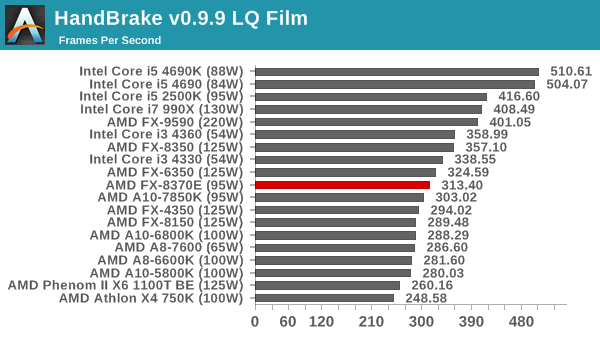
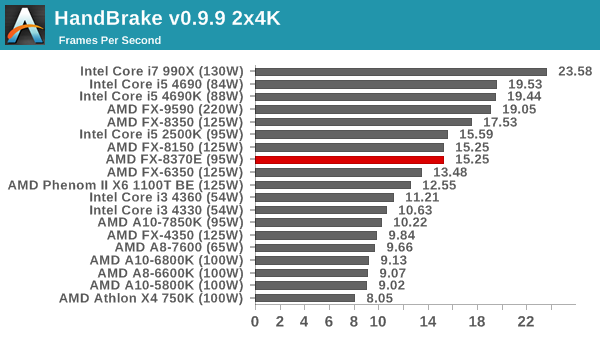
Handbrake balances cores and frequency, with the LQ film test often condensing CPUs based on frequency and the double UHD test expanding by cores. The double UHD test puts the 8370E at the bottom of the AMD 8-thread CPUs as expected.
Agisoft Photoscan – 2D to 3D Image Manipulation: link
Agisoft Photoscan creates 3D models from 2D images, a process which is very computationally expensive. The algorithm is split into four distinct phases, and different phases of the model reconstruction require either fast memory, fast IPC, more cores, or even OpenCL compute devices to hand. Agisoft supplied us with a special version of the software to script the process, where we take 50 images of a stately home and convert it into a medium quality model. This benchmark typically takes around 15-20 minutes on a high end PC on the CPU alone, with GPUs reducing the time.
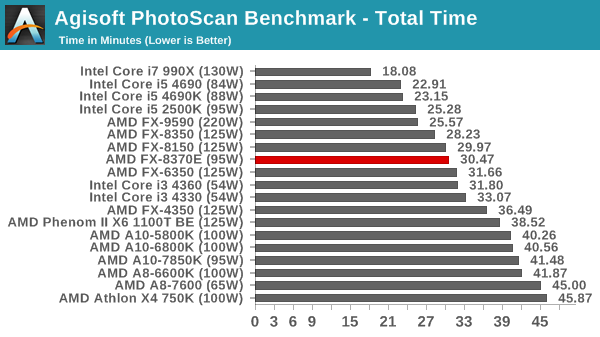
Photoscan results seem to take the following order: i7, i5, FX (8), FX (6), i3, FX (4), A10, A8. The 8370E sits at the bottom of the FX 8-thread section as before.
WinRAR 5.0.1: link

WinRAR takes advantage of all the AMD threads due to its integer workloads.
PCMark8 v2 OpenCL
A new addition to our CPU testing suite is PCMark8 v2, where we test the Work 2.0 and Creative 3.0 suites in OpenCL mode. As this test is new, we have not run it on many AMD systems yet and will do so as soon as we can.

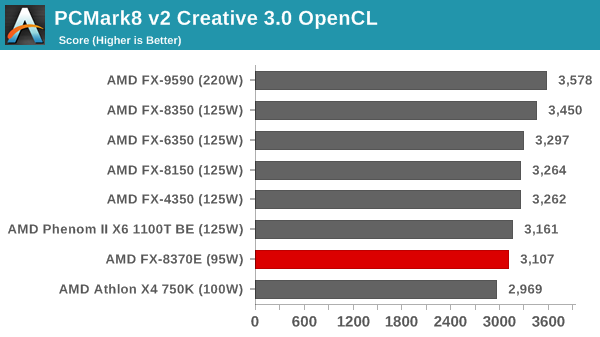
The PCMark8 tests both seem to favor frequency at this point, with the FX-9590 taking the lead.
Hybrid x265
Hybrid is a new benchmark, where we take a 4K 1500 frame video and convert it into an x265 format without audio. Results are given in frames per second.
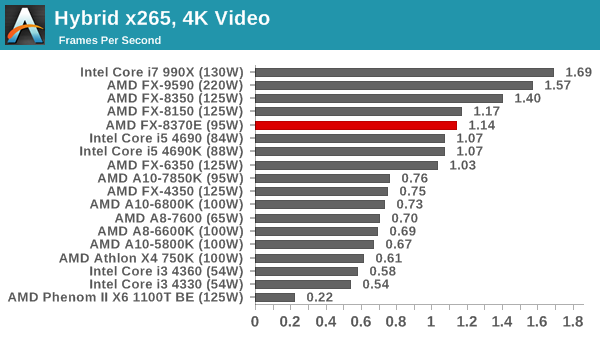
Again, more threads gives an intesting workload. The FX-8370E beats out the i5-4690K as well.
Cinebench R15
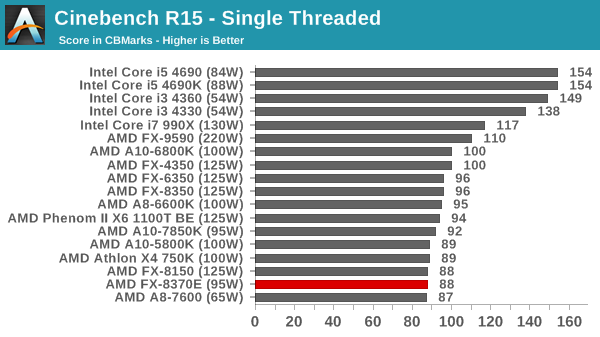

Unfortunately the Achilles heel strikes again in single threaded performance. Multithreaded puts it just behind the FX-8150.
3D Particle Movement
3DPM is a self-penned benchmark, taking basic 3D movement algorithms used in Brownian Motion simulations and testing them for speed. High floating point performance, MHz and IPC wins in the single thread version, whereas the multithread version has to handle the threads and loves more cores.

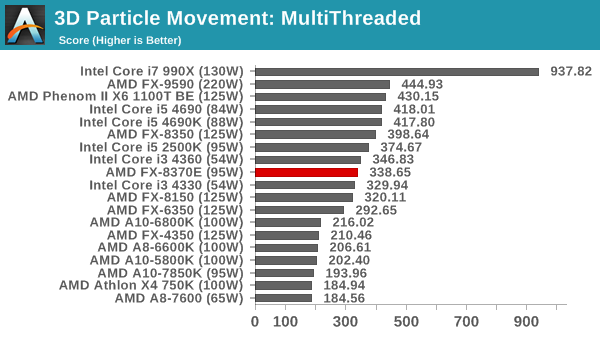
FastStone Image Viewer 4.9
FastStone is the program I use to perform quick or bulk actions on images, such as resizing, adjusting for color and cropping. In our test we take a series of 170 images in various sizes and formats and convert them all into 640x480 .gif files, maintaining the aspect ratio. FastStone does not use multithreading for this test, and results are given in seconds.
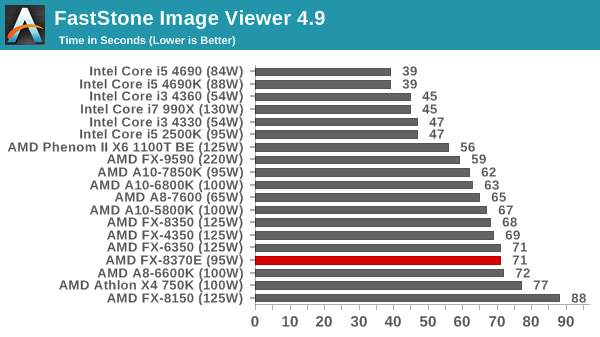
Web Benchmarks
On the lower end processors, general usability is a big factor of experience, especially as we move into the HTML5 era of web browsing. For our web benchmarks, we take four well known tests with Chrome 35 as a consistent browser.
Sunspider 1.0.2
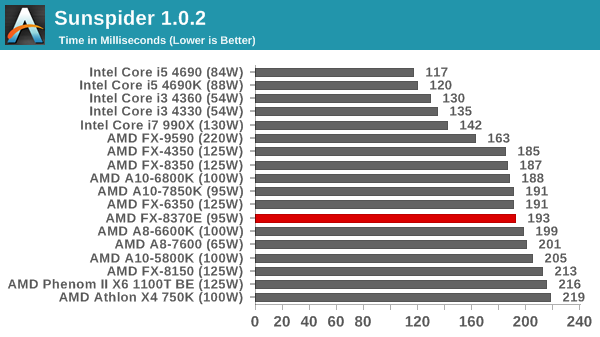
Mozilla Kraken 1.1
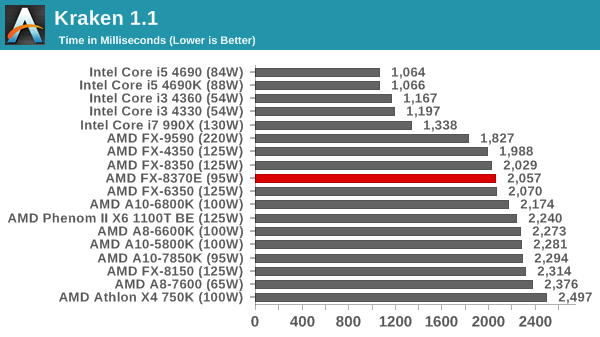
WebXPRT
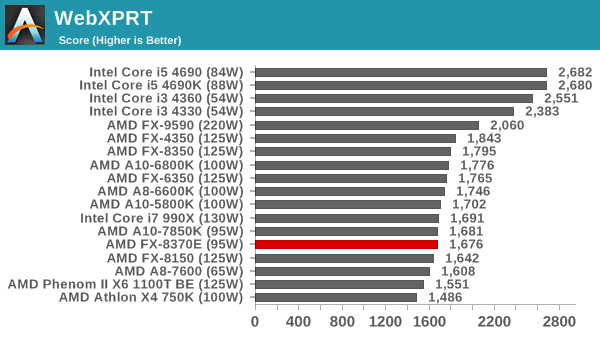
Google Octane v2
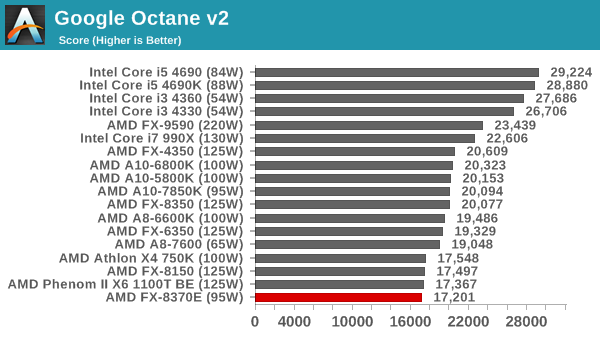










107 Comments
View All Comments
fluxtatic - Wednesday, September 3, 2014 - link
Yeah, that 40 years it held true was a total goof. That Moore, what an idiot! /sSamus - Wednesday, September 3, 2014 - link
I wish I could look more than 40 years into the future...But on a serious note, Moore's law still stands true, and will for the foreseeable future. You are right, we can't shrink things forever (we're already approaching the sub-atomic level) but there are creative ways around this; 3D transistors, quantum computing (currently vaporware IMHO) etc.
ironargonaut - Wednesday, September 3, 2014 - link
You are the fool Moore made no such assumption. Nor did he make any such statement. Others took what he said and condensed it into "Moore's law".Gigaplex - Tuesday, September 2, 2014 - link
"Seriously, how hard is to make a decent CPU"Let's see you do a better job if you think it's easy.
imin83 - Wednesday, September 3, 2014 - link
"Seriously, how hard is to make a decent CPU"-the correct reply to that statement would be, "Watch out, we got a badass over here"
IUU - Friday, September 5, 2014 - link
Well, even though I readily agree that Moore's Law will eventually come to an end, regarding the present technologies, I don't think this will happen until some years(may be 5? 10?).I bought my i7 920 at the end of 2008. So ~ 6 years later or about 3 Moore's cycles I bought a laptop
with an intel cpu that consumes officially 1/3 of the energy of the old beast. Taking into consideration the on-chip gpu, this is probably considerably less for the cpu part. Yet it performs, as a cpu,
about 10% faster on single threaded and moderately threaded applications(3-4 threaded apps). So, for any practical purpose, it's 10% faster for less than one third of the energy requirements.
If you do the multiplications and the divisions you will probably find that moore's law still holds true, not only from a manufacturing perspective but from a more substantial one;Flops per Watt.
The only problem is that performance per dollar went backwards for various reasons that are artificial and not based on the physical feasibility of things. Thus while you were purchasing a 130 watt cpu back in 2008 for ~300 dollars, now you cash out on average 500. But this is nothing.
Think about it. Many people happily waste hundreds of dollars per year for the¨"latest mobile tech", ie they spend for chips that are from an order of magnitude to possibly 2 orders of magnitude less capable, and it seems normal to almost everyone. Now go support the mobile involution in order to pay for an ordinary cpu not 1000 but 10000 dollars and then be nostalgic for the good old days when you could buy a haswell extreme for 1000 bucks.
Samus - Wednesday, September 3, 2014 - link
On one hand, AMD's stagnation is pissing me off because Intel hasn't had any competitive pressure to produce anything faster since Nehalem (Haswell is only about 20% faster in IPC, yet 5 years newer)On the other hand, Intel would still be assfucking us with Netburst if it wasn't for AMD's Athlon.
Intel strongarmed AMD out of the game. The lost revenue destroyed their R&D budget and they haven't rebounded since.
ddriver - Wednesday, September 3, 2014 - link
My biggest issue with intel is the decision to cram IGP inside high end products, which makes about ZERO sense. Integrated graphics are OK for low and lower midrange products, but in a high end product it is just waste of die space. Intel wastes 2/5 of the die on graphics which ends up never being used, and for what? To get better "video card" market share, even at the price of selling stuff that ends up never being used? Throw in 50% more cores and cache please, or just make the chip smaller and cheaper...Samus - Wednesday, September 3, 2014 - link
While I agree with you from an engineering perspective, you are free to purchase XEON or -E class CPU's if you don't like 2/5 of your die wasted.It does seem the Bloomfield Nehalem (Socket 1366) CPU's made the most efficient use of die for performance, being 45nm and all, and as soon as Intel integrated the graphics onchip it all the sudden lost its triple-channel memory controller (because there was no room left for it) so the die area can be better used, but in practice, the integrated graphics helps Intel's bottom line more than a triple channel controller or more cache, both of which 90% of consumers will benefit little from, while also increasing power consumption.
silverblue - Wednesday, September 3, 2014 - link
QuickSync could be useful...?